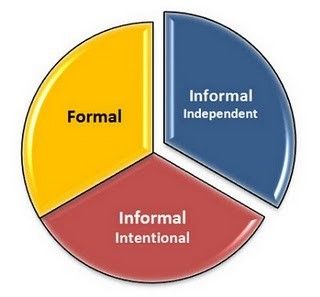

Informal learning occurs in an out-of-school setting and can be linear or non-linear and often is self-paced and visual- or object-oriented. Nformal education consists of learning activities that are voluntary and self-directed, life-long, and motivated mainly by intrinsic interests, curiosity, exploration, manipulation, fantasy, task completion, and social interaction. For example, there can be significant problems around the categorizing the education activity linked to involvement in groups and associations (la vie associative) sometimes it might be informal, at other times non-formal, and where the group is part of a school – formal. We can see similar issues in some of the discussions of informal science education in the USA. When we look more closely at the division there can be considerable overlap. These definitions do not imply hard and fast categories – as Fordham (1993) comments. (See, for example, Coombs and Ahmed 1974). interactions with friends, family and work colleagues.

Formal education is linked with schools and training institutions non-formal with community groups and other organizations and informal covers what is left, e.g. The distinction made is largely administrative. Non-formal education: any organised educational activity outside the established formal system – whether operating separately or as an important feature of some broader activity – that is intended to serve identifiable learning clienteles and learning objectives. Informal education: the truly lifelong process whereby every individual acquires attitudes, values, skills and knowledge from daily experience and the educative influences and resources in his or her environment – from family and neighbours, from work and play, from the market place, the library and the mass media.
NON FORMAL EDUCATION PROFESSIONAL
It’s best known statement comes from the work of Coombs with Prosser and Ahmed (1973):įormal education: the hierarchically structured, chronologically graded ‘education system’, running from primary school through the university and including, in addition to general academic studies, a variety of specialised programmes and institutions for full-time technical and professional training. What emerged was the influential tripartite categorization of learning systems. Lifelong learning was to be the ‘master concept’ that should shape educational systems (UNESCO 1972:182). (Fordham 1993: 2)Īt around the same time there were moves in UNESCO toward lifelong education and notions of ‘the learning society’ which culminated in Learning to Be (‘The Faure Report’, UNESCO 1972). The conclusion was that formal educational systems had adapted too slowly to the socio-economic changes around them and that they were held back not only by their own conservatism, but also by the inertia of societies themselves… It was from this point of departure that planners and economists in the World Bank began to make a distinction between informal, non-formal and formal education. Many countries were finding it difficult (politically or economically) to pay for the expansion of formal education. There was concern about unsuitable curricula a realization that educational growth and economic growth were not necessarily in step, and that jobs did not emerge directly as a result of educational inputs. Back in the late 1960s there was an emerging analysis of what was seen as a ‘world educational crisis’ (Coombs 1968). The most common way of contrasting informal and formal education derives from an administrative or institutional concern and includes a middle form – non-formal education. Looking to institutions: informal, non-formal and formal education Each of these has something to say about the nature of formal education – and bring out different aspects of the phenomenon. If we examine the literature around informal education that has appeared in the last thirty years or so, three main traditions or approaches emerge. a question of style: informality and formality.turning to process: conversation and setting.looking to institutions: informal, non-formal and formal education.

Here we explore three different approaches commonly found in the literature. Many of the debates around informal and formal education have been muddied by participants having very different understandings of basic notions.


 0 kommentar(er)
0 kommentar(er)
